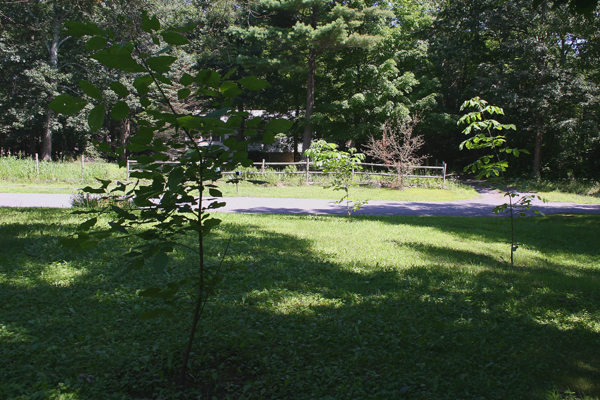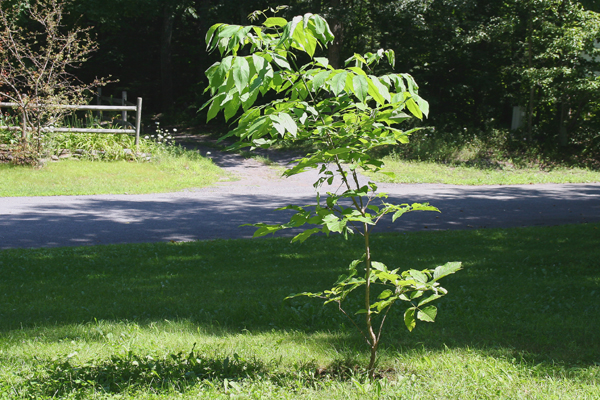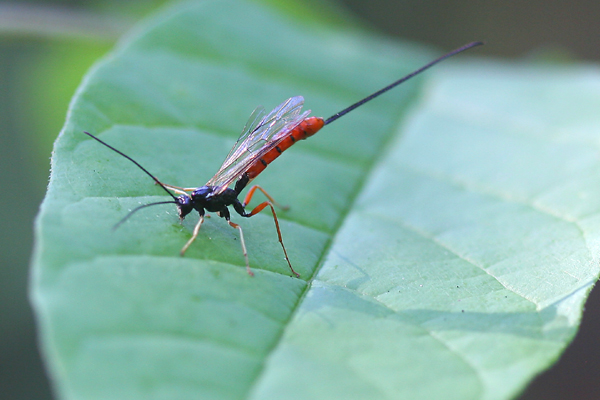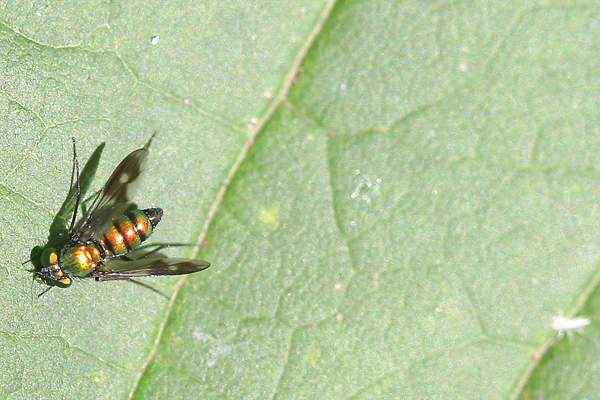Folks might remember that last year I did what I grandly called an Anti-Global Warming Big Year, the idea of which was was to see as many species as possible while burning as little carbon as possible. To offset the carbon dioxide released from a flight to California and back from my home base in New York I needed to plant trees, and I chose to plant Mountain Ash (Sorbus americana) in my parents’ yard, in the hopes that the next time Pine Grosbeaks have an irruption into New York they might decide to show up there and feed instead of up the street. It has been fifteen months since the ash were planted, and though only three of the four trees still survive I was amazed to see how they had grown when I visited my folks this weekend (they even outgrew my nieces and nephew)!
And, just like the last time I posted about the Mountain Ash, the trees are providing habitat for a host of bugs. Like last time, I found a Candy-striped Leafhopper, though it managed to avoid my camera. Even cooler than that awesomely-named insect, however, was an ichneumon wasp, one that I am actually pretty sure that I have identified down to species, a Dolichomitus irritator, one of the very few identified to species in Kaufman’s excellent Field Guide to Insects of North America. The bad news about this species is that it parasitizes wood-boring beetles, which, while I am glad that it is around to kill the beetles I assume that its presence means that wood-boring beetles might be after my ash trees!
Each tree also has its own compliment of flies of the family Dolichopodidae, the long-legged flies, of which there are 1,275 species in North America. The one below is likely from the genus Condylostylus, and, in the lower right of the photo, is what could very well be the fly’s lunch (long-legged flies are described by Kaufman as feeding “especially on mites, aphids, and smaller flies”).
Of course, there were many more bugs of which I simply couldn’t get a decent shot and a dragonfly that I am saving for a future post. I was amazed at just how much life can live on three fast growing but still small trees. I highly recommend planting your own trees: not only are they good for the planet and fascinating to pay attention to as they grow, but you will also, if you are a blogger, get a ton of material from each tree!
















Nice post, and you even managed to smuggle a bird species in (or else your blog would have to be renamed 1,000,000 Insects?).
I am however not entirely sure your trees are quite matured enough to be attractive to wood-boring beetles just yet.
In Germany we say that each man ought to plant a tree, father a son and write a book to have a fulfilled life as a “real” man. That’s two down, one to go for you (and you’re three trees ahead of me). So you’d better watch those beetles or I’ll catch up.
@Jochen: Yeah, the trees are a bit too young for wood-boring beetles, so I guess I should be glad that a ichneumon wasp is using them as a staging ground for its attacks on such beetles.
And I think that, creatively translated, “blog” could stand in for “book” and I would be fulfilled.
Do you FEEL fulfilled?
Cool shot of the wasp.
nice shot of the Candy-striped leaf hopper i love the pics and i love spending time with u. Hope to see my snorkeling pics on facebook soon
thanks for the info it helped alot with the part of my assignment that asked about mountain ash saplings and i love your pics i have some cool pics of a butterfly on a flower that u would love! thanks alot for the information.